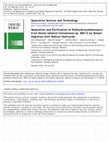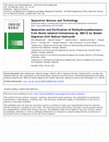Papers by Tabassum Mumtaz
European Journal of Scientific Research ISSN 1450-216X Vol.33 No.3 (2009), pp.374-384 © EuroJourn... more European Journal of Scientific Research ISSN 1450-216X Vol.33 No.3 (2009), pp.374-384 © EuroJournals Publishing, Inc. 2009 http://www.eurojournals.com/ejsr.htm ... Fed-batch Production of P(3HB-co-3HV) Copolymer by ... Comamonas sp EB 172 Using Mixed Organic Acids ...

International Journal of Polymer Analysis and Characterization, 2010
Microbial copolymer was produced by a local isolate, Comamonas sp. EB 172, using mixed organic ac... more Microbial copolymer was produced by a local isolate, Comamonas sp. EB 172, using mixed organic acids such as acetic, propionic, and butyric acids as carbon sources in pH-stat fed-batch fermentation. Maximum polymer production (6.59 g/L) was achieved at 50 h of fermentation when 73.64 g/L mixed acids, generated from the acidogenic fermentation of palm oil mill wastewater, were used. Accumulation of polymer in the cell was 70% (wt/wt), which was observed under transmission electron microscope. The morphological, chemical, thermal, and mechanical properties of the solvent-extracted biopolymer were determined by various techniques (SEM, GC, 13C NMR, FT-IR, TGA, and tensile testing). The copolymer poly(3-hydroxybutyrate-co-3-hydroxyvalerate) (PHBV) consisted of 87 mol% β-hydroxybutyric acid (HB) and 13 mol% β-hydroxyvaleric acid (HV). With chemical properties similar to commercial PHBV and mechanical strength of around 30 MPa and 8% elongation at break, the biopolymer offers potential for industrial applications.
International Journal of Polymer Analysis and Characterization, 2011
Poly(3-hydroxybutyrate-co-3-hydroxyvalerate) granule formation in vivo in wild type Comamonas sp.... more Poly(3-hydroxybutyrate-co-3-hydroxyvalerate) granule formation in vivo in wild type Comamonas sp. EB172 grown in mixed organic acids under nitrogen limitation were visualized under transmission electron microscope (TEM). The early stages of PHBV production revealed dark-stained mediation elements near the center of the cell supporting the third model of granule formation. The native granules revealed characteristic core-shell structure in which white PHB cores were surrounded by darker PHBV shells. In vitro, the copolymer showed bimodal molecular weight distribution and exhibited two melting peaks in the differential scanning calorimeter (DSC) thermogram, supporting the formation of block copolymer.

Separation Science and Technology, 2012
A simple, mild, and effective process for the recovery of intracellular polyhydroxyalkanoate from... more A simple, mild, and effective process for the recovery of intracellular polyhydroxyalkanoate from a newly isolated gram-negative wild-type bacteria Comamonas sp. EB172 was developed using sodium hydroxide. Various parameters such as sodium hydroxide concentration, digestion time, and temperature were examined for their effect on polyhydroxyalkanoate recovery. The results showed that polyhydroxyalkanoate with 88.6% purity and 96.8% recovery yield were obtained by incubating the dried cells with 0.05 M sodium hydroxide at 4°C for 1 h, followed by purification steps using ethanol and water. Removal of non-polymeric cellular materials from the Comamonas sp. EB172 was increased under alkaline solution as a result of enhanced cell wall permeability. In addition, the presence of glycerol in the polymer suspension proved that saponification of the lipid layer in the bacterial cell wall occurred due to sodium hydroxide reaction.
Journal of Cleaner Production, 2010

Separation Science and Technology, 2011
A simple, mild, and effective process for the recovery of intracellular polyhydroxyalkanoate from... more A simple, mild, and effective process for the recovery of intracellular polyhydroxyalkanoate from a newly isolated gram-negative wild-type bacteria Comamonas sp. EB172 was developed using sodium hydroxide. Various parameters such as sodium hydroxide concentration, digestion time, and temperature were examined for their effect on polyhydroxyalkanoate recovery. The results showed that polyhydroxyalkanoate with 88.6% purity and 96.8% recovery yield were obtained by incubating the dried cells with 0.05 M sodium hydroxide at 4°C for 1 h, followed by purification steps using ethanol and water. Removal of non-polymeric cellular materials from the Comamonas sp. EB172 was increased under alkaline solution as a result of enhanced cell wall permeability. In addition, the presence of glycerol in the polymer suspension proved that saponification of the lipid layer in the bacterial cell wall occurred due to sodium hydroxide reaction.
International Journal of Polymeric Materials, 2009
Micron, 2010
An outdoor soil burial test was carried out to evaluate the degradation of commercially available... more An outdoor soil burial test was carried out to evaluate the degradation of commercially available LDPE carrier bags in natural soil for up to 2 years. Biodegradability of low density polyethylene films in soil was monitored using both optical and scanning electron microscopy (SEM). After 7-9 months of soil exposure, microbial colonization was evident on the film surface. Exposed LDPE samples exhibit progressive changes towards degradation after 17-22 months. SEM images reveal signs of degradation such as exfoliation and formation of cracks on film leading to disintegration. The possible degradation mode and consequences on the use and disposal of LDPE films is discussed.
The effect of dried potato peels after acid hydrolysis (potato peel hydrolysate-PPH) supplementat... more The effect of dried potato peels after acid hydrolysis (potato peel hydrolysate-PPH) supplementation on the mycelial growth and citric acid production of Aspergillus niger CA16 was examined in medium containing sucrose and Prescott salt. In shake flask studies, addition of PPH resulted into 6-fold increment in biomass and 5 fold increment in citric acid production at 13 th day of fermentation. Supplementing PPH, therefore, can not only reduce fermentation media cost by replacing Prescott salt but also can be used along with Prescott salt for the enhanced production of citric acid from sucrose.










Uploads
Papers by Tabassum Mumtaz